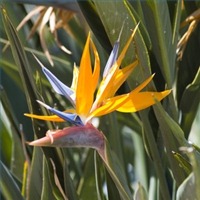Birds of paradise, sometimes called "crane" flowers, are exotic plants that produce showy flowers resembling bird heads. These plants feature thick, leathery leaves that grow up to 18 inches long and 6 inches wide. The leaves can wilt if not properly watered. Additionally, you may notice fungus spots or insect damage on the leaves. You need to take care of any or all of these issues from the start so you can enjoy a thriving bird of paradise plant.
Difficulty: Moderate
Instructions
Things You’ll Need:
- Pesticide
- Insecticidal soap
- Fungicide
-
Water your bird of paradise frequently to repair leaf-wilting. Keep the soil slightly moist during the growing season–from spring until early fall. During the plant’s dormancy (late fall and winter), water only after the soil dries out a bit, usually about 2 or 3 inches deep.
-
Identify pests causing the leaf damage; damage generally shows up as holes or spots. Aphids, grasshoppers and snails are among the most-common pests that attack bird of paradise plants. However, if you need help identifying a pest, take a sample to your county extension office or nursery for identification.
-
Treat pests with a pesticide specifically formulated for any of these parasites. Make sure you read the label and apply the pesticide according to instructions. Typically, you must spray the insects directly. Try to apply the pesticide on a calm day. Alternatively, if there is some wind, be sure it blows in the opposite direction from where you are spraying.
-
Insecticidal soaps are good alternatives to pesticides. Apply the soap as you would a pesticide, but spray both sides of the leaves. Apply in the morning or evening so the soap does not dry out too quickly to take effect. Reapply every two or three weeks as necessary.
-
Treat fungus spots, which are usually white and powdery, when they begin to spread and become unsightly. Use a fungicide for this task. Read and follow the manufacturer’s directions and spray both sides of the leaves.
However, you can prevent fungus spots from spreading before you treat the leaves. Remove old leaves and flowers as they die. Also, water near the ground if possible and in the mornings, so the leaves will dry quickly.
Tips & Warnings
-
Always wear gloves, goggles or glasses, and protective clothing when using chemicals.


Deprecated: strpos(): Passing null to parameter #1 ($haystack) of type string is deprecated in /home/agriviek8Qv/agriviet.net/public_html/wp-includes/comment-template.php on line 2522